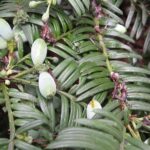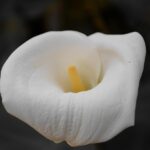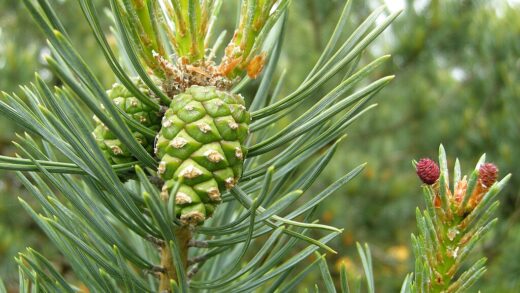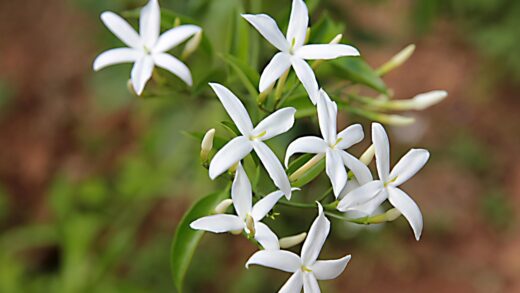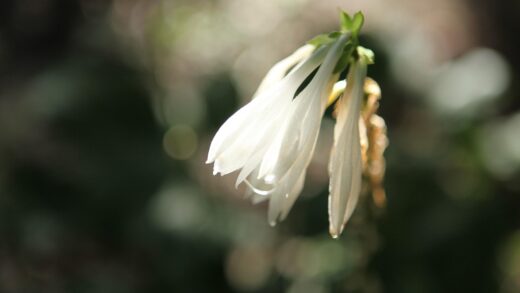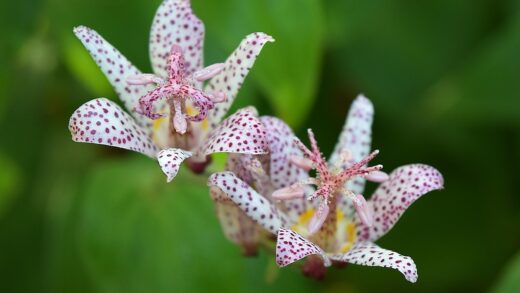The topic of pruning and cutting back the amethyst hyacinth is a simple one, yet it is of profound importance for the long-term health and perennial nature of the plant. Unlike many shrubs and perennials that require regular trimming to maintain their shape or encourage further blooming, the Brimeura amethystina has very minimal pruning needs. In fact, the most significant „pruning“ action a gardener can take is to know precisely when not to cut. The management of the plant’s foliage after flowering is the single most critical factor in ensuring the bulb has the necessary resources to survive and produce a beautiful display the following year.
The primary rule regarding the foliage of the amethyst hyacinth is that it must be allowed to die back naturally and completely without interference. After the charming, bell-shaped flowers have faded in late spring or early summer, the slender, grass-like leaves will continue to remain green for several weeks. During this vital period, they are actively photosynthesizing, capturing energy from the sun and converting it into starches and sugars. This energy is then diligently transported down and stored within the bulb, serving as the fuel for the next season’s growth.
Cutting back the foliage while it is still green is one of the most detrimental things a gardener can do to any spring-flowering bulb. This action effectively severs the plant’s lifeline, prematurely halting the energy storage process. A bulb that has had its leaves removed too early will be severely weakened and may not have enough stored reserves to produce a flower in the following spring. If this is done repeatedly over several seasons, the bulb will eventually exhaust its resources entirely and perish. Therefore, patience is paramount; the desire for a tidy garden must not override the biological needs of the plant.
The process of foliage senescence, or dieback, is a gradual one. The leaves will slowly transition from a healthy green to yellow, and finally to a dry, papery brown. Only when the leaves are completely withered and can be pulled away from the base with a gentle tug, indicating they have fully detached from the bulb, is it safe to remove them. At this point, they have completed their task, and their removal is simply a matter of garden hygiene, having no further impact on the health of the bulb sleeping below the soil.
The practice of deadheading
While cutting back the green foliage is strictly prohibited, the removal of the spent flower stalks, a practice known as deadheading, is a beneficial and recommended task. Once the individual flowers on a stalk have faded and withered, the plant’s natural inclination is to divert its energy towards the production of seeds. By snipping off the entire flower stalk at its base, you interrupt this process and redirect that energy downwards into the bulb instead. This contributes to the development of a larger, more robust bulb, which in turn can lead to an even more impressive floral display in the subsequent year.
Weitere Artikel zu diesem Thema
The timing for deadheading is as soon as the last flower on the stalk has faded. There is no benefit to leaving the unattractive, wilting flower heads on the plant. To perform the task, use a pair of clean, sharp scissors or small secateurs and make a clean cut at the bottom of the flower stem, as close to the base of the plant as possible. It is very important to be careful during this process not to accidentally cut or damage any of the healthy green leaves, as they are still actively working to feed the bulb.
Deadheading not only benefits the bulb’s development but also improves the overall appearance of the plant and the garden. Removing the spent blooms keeps the plant looking neat and tidy and focuses the visual attention on the attractive, grassy foliage. In addition, preventing the plant from setting seed can also help to control its spread if you wish to keep it contained within a specific area. However, if your goal is to encourage the plant to naturalize and self-sow to form a larger colony over time, you would deliberately choose not to deadhead, allowing the seeds to mature and disperse naturally.
It should be noted that for a large, naturalized drift of amethyst hyacinths, the task of deadheading every single flower stalk may be impractical and is certainly not essential for the plant’s survival. In such a setting, allowing the plants to complete their life cycle naturally is often part of the aesthetic appeal. The main benefit of deadheading is realized in more formal garden settings or with smaller, more curated clumps where maximizing the future performance of each individual bulb is a primary goal.
Managing the untidy phase
One of the main challenges for gardeners when it comes to bulb care is managing the visually untidy phase when the foliage begins to yellow and flop over. It is during this period that the temptation to cut everything back for a neater appearance is at its strongest. However, as established, this must be resisted. Instead, the solution lies in clever garden design and strategic companion planting to help camouflage the declining leaves.
Weitere Artikel zu diesem Thema
Planting amethyst hyacinths amongst other perennials that begin to emerge and fill out in late spring is an excellent strategy. As the bulb foliage starts to fade, the growing leaves of plants like hardy geraniums, lady’s mantle (Alchemilla mollis), or even the foliage of daylilies can expand to cover the withering leaves, effectively hiding them from view. This creates a seamless visual transition in the border, with the companion plants taking over the display just as the bulbs are finishing their cycle. This approach allows the bulbs to complete their energy storage process undisturbed while maintaining a neat and attractive garden appearance.
In a container planting, the same principle can be applied. You can underplant the bulbs with low-growing, trailing annuals or perennials that will spill over the edges of the pot and help to disguise the dying foliage. Plants like trailing lobelia, sweet alyssum, or creeping thyme can work well for this purpose. Alternatively, you can design your containers with a mix of plants, where the bulbs provide the early spring interest, and other plants are positioned to grow up and take center stage as the season progresses.
Another technique, sometimes seen but not recommended, is to braid or tie the long, floppy leaves into knots to make them look tidier. While this may seem like a neat solution, it can actually be detrimental. Folding and tying the leaves can damage their cellular structure and reduces the surface area that is exposed to sunlight. This can impair the efficiency of photosynthesis and may reduce the amount of energy the bulb is able to store. The best and most effective method is always to leave the foliage completely alone to die back at its own pace, using companion plants as a clever visual screen.
No requirement for shaping or formative pruning
It is important to clarify that Brimeura amethystina, being a bulbous perennial with a distinct growth habit, has absolutely no need for the kind of formative or structural pruning that is applied to shrubs and trees. The plant’s shape and size are determined by its natural growth cycle. It produces a clump of basal leaves and a flower stalk, and that is its entire above-ground structure for the season. There is no woody framework to maintain and no branching to encourage.
Any cutting done to the plant during its active growth phase would be purely damaging. The concept of „pruning for shape“ is entirely irrelevant to this type of plant. The aesthetic appeal of the amethyst hyacinth comes from its natural, graceful form, and the best way to appreciate this is to allow it to grow without interference. The gardener’s role is not to shape the plant, but to provide the right conditions for it to express its natural beauty.
Similarly, there is no need to „thin out“ the foliage during the growing season. The number of leaves produced is directly related to the size and health of the bulb. A vigorous bulb will produce a healthy clump of leaves to support its flowering. Removing any of these leaves would only serve to weaken the plant by reducing its photosynthetic capacity. The clump will naturally regulate its own density, and if it becomes too crowded over several years, the solution is not to prune the leaves but to lift and divide the bulbs during their dormant season.
The only time cutting tools should be used on an amethyst hyacinth, other than for deadheading, is for sanitation purposes. If you notice a leaf or part of a flower stalk that shows clear signs of a fungal disease, it is wise to carefully remove that specific part to prevent the disease from spreading. However, this is a targeted remedial action, not a routine pruning practice. In a healthy plant, the only regular cutting required is the removal of the spent flower stem.
Post-dormancy clean-up
The final act of „cutting back“ for the amethyst hyacinth occurs long after the plant has finished its active cycle for the year. This is the simple and final clean-up of the fully withered foliage. Once the leaves have turned completely brown and papery and are dry to the touch, they have served their purpose. At this point, they can be removed to tidy up the garden bed in preparation for winter or the next growing season.
This final clean-up can be done in late summer or autumn. In most cases, the dried leaves will be so brittle that they can be easily gathered up by hand, often detaching from the ground with no effort at all. If any tougher stems remain, they can be snipped off at ground level. Removing this dead organic material can help to improve air circulation around the base of the plant for the following spring and can also reduce potential overwintering sites for pests like slugs.
This post-dormancy clean-up is the bookend to the care cycle that began with the emergence of the shoots in spring. It represents the successful completion of the plant’s annual journey. By correctly managing the foliage—deadheading the spent flowers but preserving the leaves until they have fully withered—the gardener ensures that the bulb has been fully recharged. This simple, patient approach to cutting back is the key to guaranteeing that your amethyst hyacinths will return year after year, gracing your garden with their delicate and beautiful blooms.
This act of clearing away the old, dead growth is also a good opportunity to apply a winter mulch if you live in a particularly cold climate. After the debris has been removed, a loose layer of shredded leaves or bark can be applied over the top of the soil. This will provide an extra layer of insulation for the dormant bulbs throughout the winter, protecting them from the harshest temperatures and ensuring they are ready to burst forth with renewed energy in the spring.









